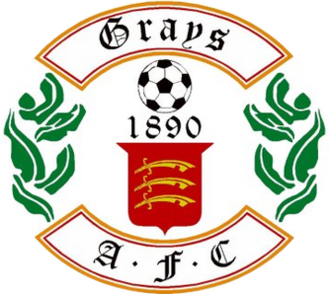Grays Athletic FC
- Paul Grange

- Sep 1
- 3 min read
Grays in Essex does have a fairly rich history and heritage fron which to draw upon when creating a badge for their team

. However, their current badge is a fairly simple affair featuring the county badge. The three curved blades gleaming on a field of red. They’re not swords, not scimitars – but seaxes, the Anglo-Saxon short swords that gave Essex its very name: the land of the East Saxons.
The same motif is carried around Essex by the likes of Southend United and the Essex County Cricket Club.
Grays sits on the Essex side of the Thames. Sandwiched between Tilbury and the Queen Elizabeth II Bridge (Dartford Crossing – to most of us).
The town’s name itself tells the story. “Thurrock” is Saxon for “the bottom of a ship,” a nod to the Thames and trade. “Grays” comes from Henry de Grey, a Norman knight gifted the manor here by King Richard I in 1195. His descendants rose to power, and the blue-and-white stripes of the Grey family arms echo still in the club’s colours – The Blues.
But the real soul of Grays is not knights or kings, but workers. From the 19th century onwards, the gravel pits, chalk quarries, and cement works carved into Thurrock’s landscape gave the town its nickname. Just as the dockers gave identity to Millwall and the miners to Barnsley, so too did the labourers of Thurrock gift their club its name: The Gravelmen.
Grays’ gravel built London. Sittingbourne on the Kent side dug the bricks, Thurrock dug the stone – the capital rose from their graft. Lakeside Shopping Centre, one of Britain’s retail giants, even stands today on the site of an old cement works. And tucked into this industrial heritage, Grays Athletic football club was founded in 1890, carrying the spirit of the pits onto the pitch.
For much of their history, Grays lived the life of a non-league journeyman. The Hoppit Ground gave way to the New Recreation Ground, their home for over a century until developers forced a nomadic era of groundshares – Aveley, East Thurrock, Tilbury. But no matter where they played, the Gravelmen carried Thurrock and Grays with them.
The club’s golden age came in the early 2000s. Backed by Mick Woodward and managed by former Spurs midfielder Mark Stimson, Grays were unstoppable. Founder members of the new Conference South in 2004–05, they won it at the first attempt. Not content, they lifted the FA Trophy too, beating Hucknall Town on penalties at Villa Park.
The following year, with players like Jamie Stuart, Stuart Thurgood, Aaron McLean and a young Michael Kightly, they stormed to third place in the Conference National, just shy of the Football League dream. To crown it all, they retained the FA Trophy at West Ham’s Boleyn Ground, with nearly 10,000 Blues in the stands. Goals from Kightly and Glenn Poole sealed it – Grays Athletic, back-to-back Wembley giants in all but name.
Grays has always been more than a football town. Samuel Pepys recorded buying fish here in 1665. Alfred Russel Wallace, co-discoverer of evolution, built The Dell, one of Britain’s earliest concrete houses, in Grays. And the town’s chalk pits and landfill sites tell the Victorian story of London’s insatiable hunger for resources.
The club, too, has sent players up the pyramid. Freddy Eastwood, who famously scored a hat-trick against Derby in seven minutes, began here. And more recently, Freddie Ladapo, of recent Ipswich Town fame, wore the blue of the Gravelmen before stepping into the EFL spotlight.
Today, Grays are fighting their way in the Isthmian League North, groundsharing at Tilbury while they prepare to take over Ship Lane – the former home of Thurrock FC – in time for the 2026–27 season. It’s a project that promises stability after years on the road.
Through it all, the badge endures. Three seaxes, white on red, the emblem of Essex. Behind them sits the story of Henry de Grey, of gravel pits and Saxon kingdoms, of Pepys and Wallace, of players who rose to the big time, and fans who never left.







Comments